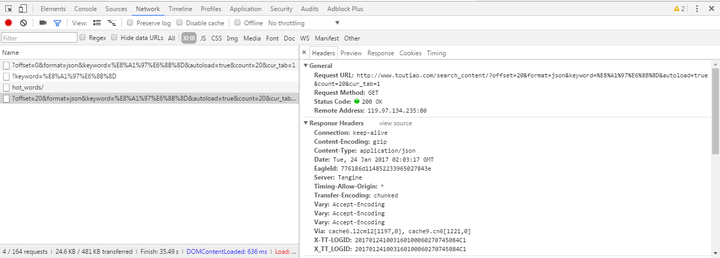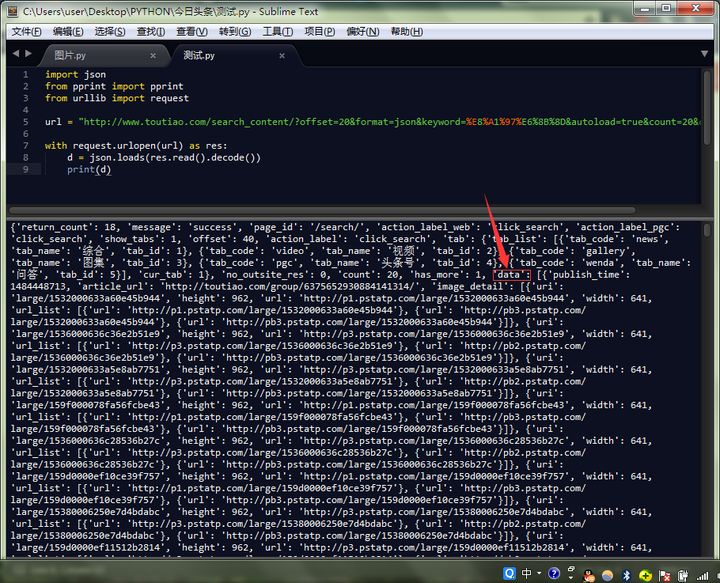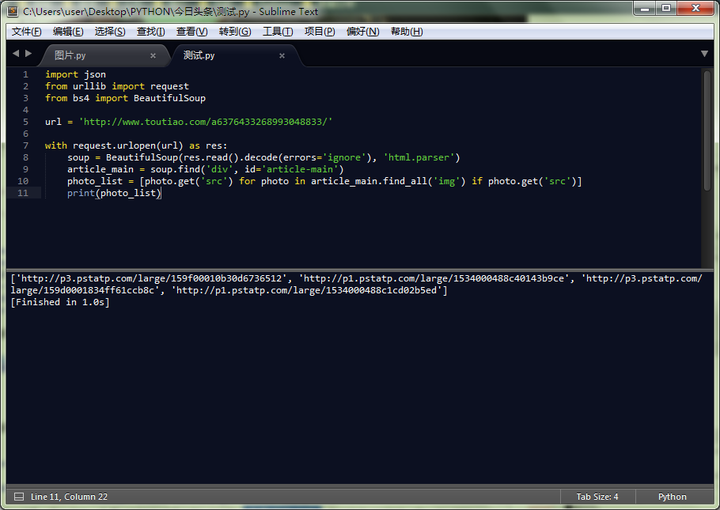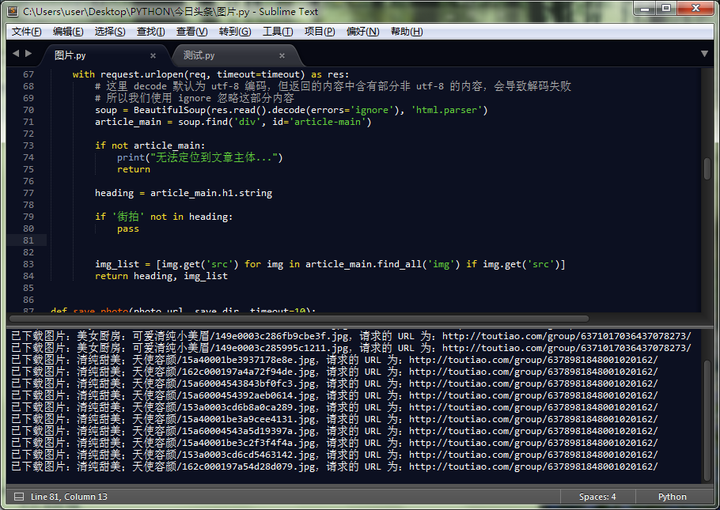Python爬虫实战——爬取今日头条美女图片,,?推荐下我自己创建的
Python爬虫实战——爬取今日头条美女图片,,?推荐下我自己创建的

?
推荐下我自己创建的Python学习交流群923414804,这是Python学习交流的地方,不管你是小白还是大牛,小编都欢迎,不定期分享干货,包括我整理的一份适合零基础学习Python的资料和入门教程。
笔者是头条的深度使用者,经常用头条完成“看片”大业。若不信的话可以试试在头条搜索街拍,返回的都是一道道靓丽的风景线。
想把图片存下来,该怎么办呢?我们可以用Python爬虫啊。
1、工具
Python3.5,Sublime Text,Windows 7
2、分析(第三步有完整代码)
可以看到搜索结果默认返回了 20 篇文章,当页面滚动到底部时头条通过 ajax 加载更多文章,浏览器按下 F12 打开调试工具(我的是 Chrome),点击 Network 选项,尝试加载更多的文章,可以看到相关的 http 请求:

?
此次返回Request URL:
http://www.toutiao.com/search_content/?offset=20&format=json&keyword=%E8%A1%97%E6%8B%8D&autoload=true&count=20&cur_tab=1
来试试返回了什么
import jsonfrom urllib import requesturl = "http://www.toutiao.com/search_content/?offset=20&format=json&keyword=%E8%A1%97%E6%8B%8D&autoload=true&count=20&cur_tab=1"with request.urlopen(url) as res: d = json.loads(res.read().decode()) print(d)
?
发现我们需要的东西在‘data‘里,打开一篇文章,来试试如何下载单篇图片。
import jsonfrom urllib import requesturl = ‘http://www.toutiao.com/a6314996711535444226/#p=1‘with request.urlopen(url) as res: soup = BeautifulSoup(res.read().decode(errors=‘ignore‘), ‘html.parser‘) article_main = soup.find(‘div‘, id=‘article-main‘) photo_list = [photo.get(‘src‘) for photo in article_main.find_all(‘img‘) if photo.get(‘src‘)] print(photo_list)
?
输出
[‘http://p3.pstatp.com/large/159f00010b30d6736512‘, ‘http://p1.pstatp.com/large/1534000488c40143b9ce‘, ‘http://p3.pstatp.com/large/159d0001834ff61ccb8c‘, ‘http://p1.pstatp.com/large/1534000488c1cd02b5ed‘]
首先用BeautifulSoup解析网页,通过 find 方法找到 article-main 对应的 div 块,在该 div 块下继续使用 find_all 方法搜寻全部的 img 标签,并提取其 src 属性对应的值,于是我们便获得了该文章下全部图片的 URL 列表。
接下来就是保存图片。
photo_url = "http://p3.pstatp.com/large/159f00010b30d6736512"photo_name = photo_url.rsplit(‘/‘, 1)[-1] + ‘.jpg‘with request.urlopen(photo_url) as res, open(photo_name, ‘wb‘) as f: f.write(res.read())基本步骤就是这么多了,整理下爬取流程:
指定查询参数,向http://www.toutiao.com/search_content/提交我们的查询请求。从返回的数据(JSON 格式)中解析出全部文章的 URL,分别向这些文章发送请求。从返回的数据(HTML 格式)提取出文章的标题和全部图片链接。再分别向这些图片链接发送请求,将返回的图片输入保存到本地(E:\jiepai)。修改查询参数,以使服务器返回新的文章数据,继续第一步。3、完整代码
import reimport jsonimport timeimport randomfrom pathlib import Pathfrom urllib import parsefrom urllib import errorfrom urllib import requestfrom datetime import datetimefrom http.client import IncompleteReadfrom socket import timeout as socket_timeoutfrom bs4 import BeautifulSoupdef _get_timestamp(): """ 向 http://www.toutiao.com/search_content/ 发送的请求的参数包含一个时间戳, 该函数获取当前时间戳,并格式化成头条接收的格式。格式为 datetime.today() 返回 的值去掉小数点后取第一位到倒数第三位的数字。 """ row_timestamp = str(datetime.timestamp(datetime.today())) return row_timestamp.replace(‘.‘, ‘‘)[:-3]def _create_dir(name): """ 根据传入的目录名创建一个目录,这里用到了 python3.4 引入的 pathlib 库。 """ directory = Path(name) if not directory.exists(): directory.mkdir() return directorydef _get_query_string(data): """ 将查询参数编码为 url,例如: data = { ‘offset‘: offset, ‘format‘: ‘json‘, ‘keyword‘: ‘街拍‘, ‘autoload‘: ‘true‘, ‘count‘: 20, ‘_‘: 1480675595492 } 则返回的值为: ?offset=20&format=json&keyword=%E8%A1%97%E6%8B%8D&autoload=true&count=20&_=1480675595492" """ return parse.urlencode(data)def get_article_urls(req, timeout=10): with request.urlopen(req, timeout=timeout) as res: d = json.loads(res.read().decode()).get(‘data‘) if d is None: print("数据全部请求完毕...") return urls = [article.get(‘article_url‘) for article in d if article.get(‘article_url‘)] return urlsdef get_photo_urls(req, timeout=10): with request.urlopen(req, timeout=timeout) as res: # 这里 decode 默认为 utf-8 编码,但返回的内容中含有部分非 utf-8 的内容,会导致解码失败 # 所以我们使用 ignore 忽略这部分内容 soup = BeautifulSoup(res.read().decode(errors=‘ignore‘), ‘html.parser‘) article_main = soup.find(‘div‘, id=‘article-main‘) if not article_main: print("无法定位到文章主体...") return heading = article_main.h1.string if ‘街拍‘ not in heading: print("这不是街拍的文章!!!") return img_list = [img.get(‘src‘) for img in article_main.find_all(‘img‘) if img.get(‘src‘)] return heading, img_listdef save_photo(photo_url, save_dir, timeout=10): photo_name = photo_url.rsplit(‘/‘, 1)[-1] + ‘.jpg‘ # 这是 pathlib 的特殊操作,其作用是将 save_dir 和 photo_name 拼成一个完整的路径。例如: # save_dir = ‘E:\jiepai‘ # photo_name = ‘11125841455748.jpg‘ # 则 save_path = ‘E:\jiepai\11125841455748.jpg‘ save_path = save_dir / photo_name with request.urlopen(photo_url, timeout=timeout) as res, save_path.open(‘wb‘) as f: f.write(res.read()) print(‘已下载图片:{dir_name}/{photo_name},请求的 URL 为:{url}‘ .format(dir_name=dir_name, photo_name=photo_name, url=a_url))if __name__ == ‘__main__‘: ongoing = True offset = 0 # 请求的偏移量,每次累加 20 root_dir = _create_dir(‘E:\jiepai‘) # 保存图片的根目录 request_headers = { ‘Referer‘: ‘http://www.toutiao.com/search/?keyword=%E8%A1%97%E6%8B%8D‘, ‘User-Agent‘: ‘Mozilla/5.0 (Windows NT 10.0; Win64; x64) AppleWebKit/537.36 (KHTML, like Gecko) Chrome/54.0.2840.99 Safari/537.36‘ } while ongoing: timestamp = _get_timestamp() query_data = { ‘offset‘: offset, ‘format‘: ‘json‘, ‘keyword‘: ‘街拍‘, ‘autoload‘: ‘true‘, ‘count‘: 20, # 每次返回 20 篇文章 ‘_‘: timestamp } query_url = ‘http://www.toutiao.com/search_content/‘ + ‘?‘ + _get_query_string(query_data) article_req = request.Request(query_url, headers=request_headers) article_urls = get_article_urls(article_req) # 如果不再返回数据,说明全部数据已经请求完毕,跳出循环 if article_urls is None: break # 开始向每篇文章发送请求 for a_url in article_urls: # 请求文章时可能返回两个异常,一个是连接超时 socket_timeout, # 另一个是 HTTPError,例如页面不存在 # 连接超时我们便休息一下,HTTPError 便直接跳过。 try: photo_req = request.Request(a_url, headers=request_headers) photo_urls = get_photo_urls(photo_req) # 文章中没有图片?跳到下一篇文章 if photo_urls is None: continue article_heading, photo_urls = photo_urls # 这里使用文章的标题作为保存这篇文章全部图片的目录。 # 过滤掉了标题中在 windows 下无法作为目录名的特殊字符。 dir_name = re.sub(r‘[\\/:*?"<>|]‘, ‘‘, article_heading) download_dir = _create_dir(root_dir / dir_name) # 开始下载文章中的图片 for p_url in photo_urls: # 由于图片数据以分段形式返回,在接收数据时可能抛出 IncompleteRead 异常 try: save_photo(p_url, save_dir=download_dir) except IncompleteRead as e: print(e) continue except socket_timeout: print("连接超时了,休息一下...") time.sleep(random.randint(15, 25)) continue except error.HTTPError: continue # 一次请求处理完毕,将偏移量加 20,继续获取新的 20 篇文章。 offset += 20同理,只需修改代码,就可以下载想要的关键词,自己动手,想啥有啥。

?
Python爬虫实战——爬取今日头条美女图片
相关内容
- python3网络爬虫学习——基本库的使用(1),,最近入手
- [python]pycharm画图插件matplotlib、numpy、scipy的下载与安装
- Vim下一键运行python代码,,根据系统将下面代码复
- Python3中的super()函数详解,,关于Python3中
- python中的列表和字典(二),,三. 字典以及相关使
- MacOS怎么安装ChromeDriver,,由于我用的MAC电脑
- 格式化字符串的4种方式,,目录:Python格
- 正则表达式,,正则表达式正则表达式
- Python 进制转换、位运算,,一、进制转换编程用十
- python之OpenCv(四)---人脸识别,,对特定图像进行识别,
评论关闭